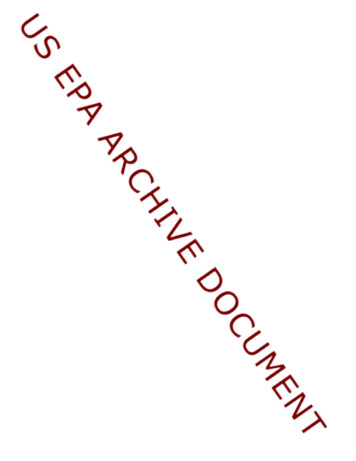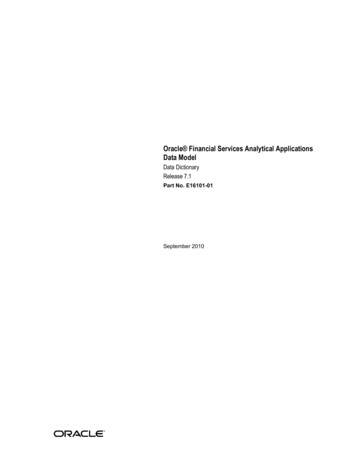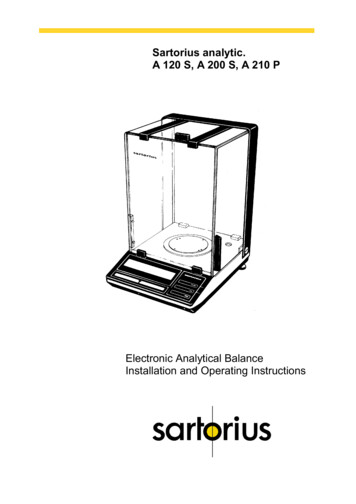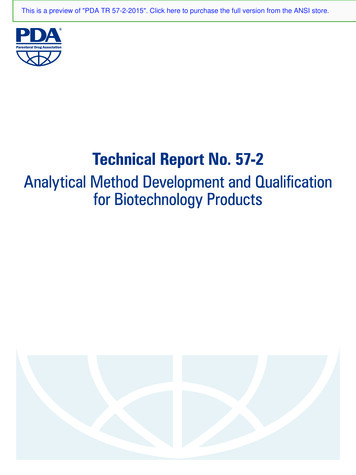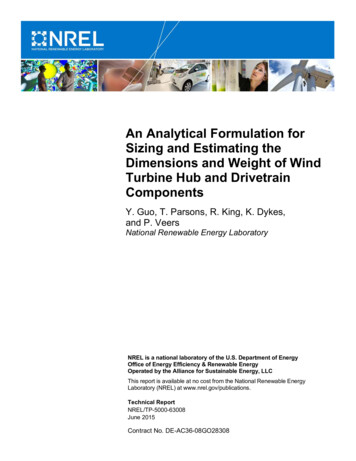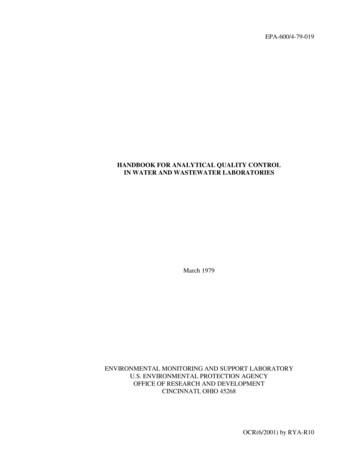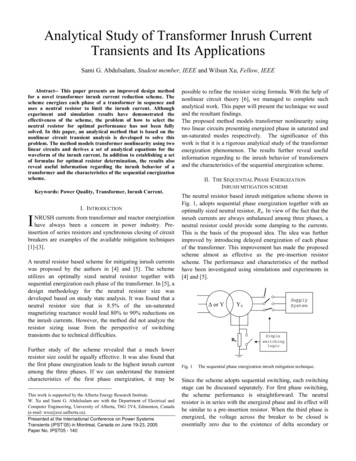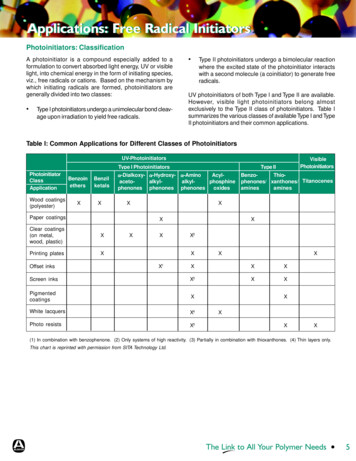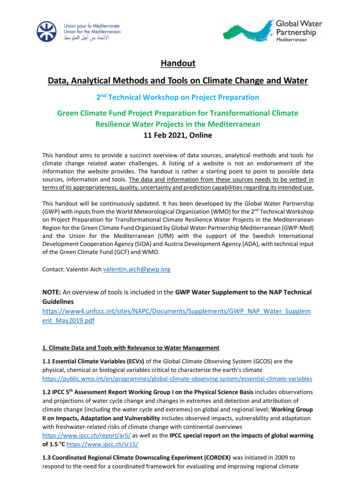
Transcription
HandoutData, Analytical Methods and Tools on Climate Change and Water2nd Technical Workshop on Project PreparationGreen Climate Fund Project Preparation for Transformational ClimateResilience Water Projects in the Mediterranean11 Feb 2021, OnlineThis handout aims to provide a succinct overview of data sources, analytical methods and tools forclimate change related water challenges. A listing of a website is not an endorsement of theinformation the website provides. The handout is rather a starting point to point to possible datasources, information and tools. The data and information from these sources needs to be vetted interms of its appropriateness, quality, uncertainty and prediction capabilities regarding its intended use.This handout will be continuously updated. It has been developed by the Global Water Partnership(GWP) with inputs from the World Meteorological Organization (WMO) for the 2nd Technical Workshopon Project Preparation for Transformational Climate Resilience Water Projects in the MediterraneanRegion for the Green Climate Fund Organized by Global Water Partnership Mediterranean (GWP-Med)and the Union for the Mediterranean (UfM) with the support of the Swedish InternationalDevelopment Cooperation Agency (SIDA) and Austria Development Agency (ADA), with technical inputof the Green Climate Fund (GCF) and WMO.Contact: Valentin Aich valentin.aich@gwp.orgNOTE: An overview of tools is included in the GWP Water Supplement to the NAP APC/Documents/Supplements/GWP NAP Water Supplement May2019.pdf1. Climate Data and Tools with Relevance to Water Management1.1 Essential Climate Variables (ECVs) of the Global Climate Observing System (GCOS) are thephysical, chemical or biological variables critical to characterize the earth’s les1.2 IPCC 5th Assessment Report Working Group I on the Physical Science Basis includes observationsand projections of water cycle change and changes in extremes and detection and attribution ofclimate change (including the water cycle and extremes) on global and regional level; Working GroupII on Impacts, Adaptation and Vulnerability includes observed impacts, vulnerability and adaptationwith freshwater-related risks of climate change with continental overviewshttps://www.ipcc.ch/report/ar5/ as well as the IPCC special report on the impacts of global warmingof 1.5 C https://www.ipcc.ch/sr15/1.3 Coordinated Regional Climate Downscaling Experiment (CORDEX) was initiated in 2009 torespond to the need for a coordinated framework for evaluating and improving regional climate
Handout Data, Analytical Methods and Tools on Climate Change and Water2nd Technical Workshop on Project Preparation for Transformational ClimateResilience Water Projects in the Mediterranean Region for the GCFdownscaling (RCD) techniques and producing a new generation of RCD-based fine-scale climateprojections for specific regions worldwide. http://cordex.org/1.4 EU Copernicus Climate Change Service (C3S) provides a wide portfolio of data and products andservices, including monthly maps and charts of essential climate variables, including hydrologicalclimate variables https://climate.copernicus.eu/1.5 Global Climate Change Viewer (GCCV) displays future temperature and precipitation changessimulated by global climate models in the Coupled Model Intercomparison Project Phase 5 (CMIP5).Users can view projections for any country, for all available models, and all RepresentativeConcentration Pathways (RCP) emission scenarios. Includes detailed usage 5-global-climate-change-viewer-gccv1.6 CCAFS-Climate data portal provides global and regional high-resolution climate datasets that canbe used as a basis for assessing the climate change impacts and adaptation in a variety of fieldsincluding hydrology, biodiversity, agricultural and livestock production, and ecosystem services.http://ccafs-climate.org/1.7 Climate Wizard is an easy to use tool to visualize IPCC AR4 (2007) climate projectionshttp://www.climatewizard.org/1.8 KNMI Climate Explorer is a research tool to investigate the climate. Its web site collects a lot ofclimate data and analysis tools to visualize for example CORDEX https://climexp.knmi.nl/Figure: Sample visualization of the difference between Rainfall in the periods 1986-2005 and 20812100 on GCM CMIP5 dataset (KNMI Climate Explorer)1.9 World Bank Climate Change Knowledge Portal (CCKP) provides information, data and reportsabout climate change including country index.cfm1.10 Global Climate Monitor is a global climate web viewer to geo-visualize climate data andclimate-environmental indicator http://www.globalclimatemonitor.org/1.11 Community-based Risk Screening Tool – Adaptation and Livelihoods (CRiSTAL) is a projectplanning tool that helps users design activities that support adaptation to climate variability andchange at the community level https://www.iisd.org/cristaltool/1.12 Climate vulnerability Assessment (Annex to USAID Climate-Resilient Development Framework)provides a conceptual framework for carrying out vulnerability assessment and provides listings oftools and resources that can be used throughout the vulnerability assessment processPage 2 out of 7
Handout Data, Analytical Methods and Tools on Climate Change and Water2nd Technical Workshop on Project Preparation for Transformational ClimateResilience Water Projects in the Mediterranean Region for the ent-development-framework WMO Catalogue for Climate Data has just been approved by WMO Congress. This will enhancethe discoverability, access and use of high-quality climate data and provide a one-stop platform forassessing maturity and quality of climate datasets, thus increasing the visibility of the best data.https://climatedata-catalogue.wmo.int/2. Water Data, Tools and Models2.1 WMO Hydrological Observing System (WHOS) is a portal to the online holdings of NationalHydrological Services (NHS) around the world that publish their historical and/or real-time datawithout restrictions or cost php2.2 AQUASTAT provides standardized data and information and tools to generate analysis on waterresources, water uses, agricultural water n/index.stm2.3 Integrated Flood Management Help Desk provides 24 tools and several guidelines as well as afunction to request tailor-made support from a community of 35 expert organizations on floodmanagement including early warning systems http://www.floodmanagement.info/2.4 Integrated Drought Management Help Desk provides tools and guidelines as well as a functionto request tailor-made support from a community of 34 expert organizations on droughtmanagement including monitoring, early warning systems; vulnerability and impact assessment;preparedness and drought mitigation measures http://www.droughtmanagement.info/2.5 Flood and Drought Monitor is a portal where users can map satellite data to support theirplanning for flood and drought events http://www.flooddroughtmonitor.com/2.6 Global Water Tool (GWT) to identify corporate water risks and esources/Global-Water-Tool2.7 Global Flood Awareness System (GloFAS) couples weather forecasts with a hydrological modelfor information on river conditions and continental and global overviews.http://globalfloods.jrc.ec.europa.eu/2.8 Water Risk Filter a tool to visualize water data and analysis http://waterriskfilter.panda.org/2.9 AQUEDUCT Water Risk Atlas allows mapping water indicators on a global level to identify waterrisks broadly s includes also a Global FloodAnalyzer http://floods.wri.org/#/2.10 SMHI HypeWeb publish modelled Open Data for inspection and free download from multi-basinand large-scale applications of the Hydrological Predictions for the Environment (HYPE) model. Themodel includes Northern Africa. http://hypeweb.smhi.se/2.11 Community Water Model is an opensource model to examine how future water demand willevolve in response to socioeconomic change and how water availability will change in response toclimate earchPrograms/water/Community Water Model.htmlPage 3 out of 7
Handout Data, Analytical Methods and Tools on Climate Change and Water2nd Technical Workshop on Project Preparation for Transformational ClimateResilience Water Projects in the Mediterranean Region for the GCF2.12 Global Hydro-economic Model is a bottom-up system analysis framework which can be used todevelop integrated, long-term planning strategies for the water system to address the impacts offuture changing socio-economic and climatic conditions on the water earchPrograms/water/Global Hydroeconomic Model.html2.13 The Inter-Sectoral Impact Model Intercomparison Project (ISIMIP) is a community-drivenclimate-impacts modelling initiative. Models on “Global Water” and “Regional Water” have beencontributed for which data can be downloaded (explore with the Search function). Papers have alsobeen published with analysis of the models. https://www.isimip.org/outputdata/2.14 Emergency Events Database (EM-DAT) contains data on the occurrence and effects of over22,000 mass disasters (including water-related disasters) in the world from 1900 to the present dayhttp://www.emdat.be/2.15 Global Runoff Data Centre (GRDC) provides long time series of runoff data around the worldhttp://www.bafg.de/GRDC/EN/Home/homepage node.html2.16 Global Precipitation Climatology Centre (GPCC) provides gridded monthly and dailyprecipitation data sets 17 Global Groundwater Information System (GGIS) of IGRAC (International GroundwaterResources Assessment Centre), providing information and data on Groundwater around the nformation-system-ggis the Global GroundwaterMonitoring Network (GGMN) a web-based network of networks displaying groundwater level dataand changes occurring in groundwater levels is also available at l-groundwater-monitoring-network2.18 International Data Centre on Hydrology of Lakes and Reservoirs (HYDROLARE), hosting globaldata on lake and reservoirs. http://hydrolare.net/2.19 Consortium of Universities for the Advancement of Hydrologic Science (CUHASI) Water dataportal, listing existing data information websites https://www.cuahsi.org/data-models/portals/2.20 Group on Earth Observations System of Systems (GEO SS) Portal for access of earthobservation data from different archives http://www.geoportal.org/2.21 EartH2Observe Water Cycle Integrator (WCI) provides a portal to view and analyse earthobservation, in-situ and model data https://wci.earth2observe.eu/2.22 Global Flood Monitoring System (GFMS) is a NASA-funded experimental system using real-timeTRMM Multi-satellite Precipitation Analysis (TMPA) precipitation information, hydrological runoffand routing model running, streamflow, surface water storage, inundation variables. In addition, thelatest maps of instantaneous precipitation and totals from the last day, three days and seven daysare displayed http://flood.umd.edu/2.23 Global Precipitation Measurement (GPM) mission provides data from an international networkof satellites for the global observation of rain and snow data are improvements to our understandingand forecasting of tropical cyclones, extreme weather, floods, landslides, land surface models, thespread of water-borne diseases, agriculture, freshwater availability and climate erPage 4 out of 7
Handout Data, Analytical Methods and Tools on Climate Change and Water2nd Technical Workshop on Project Preparation for Transformational ClimateResilience Water Projects in the Mediterranean Region for the GCF2.24 Global Flood Alert System (GFAS) uses global satellite precipitation estimates for floodforecasting and warning /2.25 Real-time Integrated Global Flood Map is an experimental platform to map extreme rainfallhttp://dma.jrc.it/map/?application FLOODS3. Regional Institutions and Mechanisms with technical resources3.1 Regional Climate Centres (RCCs)WMO designated (a) Global Producing Centres for Long-Range Forecasts (GPCLRFs) to provide arange of global long-range forecasting products and (b) Regional Climate Centres (RCCs) to generateand deliver more regionally-focused high-resolution data and products as well as training andcapacity building. The GPCLRFs and the RCCs constitute integral components of WMO's Global DataProcessing and Forecasting System (GDPFS) underpinning the generation of climate informationproducts by the NMHSs.As Centres of Excellence, the WMO RCCs create regional products including long-range forecasts thatsupport regional and national activities and thereby strengthen capacity of WMO Members in a givenregion to deliver the best climate services to national users.RCCs in the MediterraneanRegional Climate Network Northern AfricaThe nodes are:(1) Casablanca Node on Long-Range Forecasting led by Direction de la MétéorologieNationale (DMN), Morocco; (2) Tunis Node on Climate Monitoring led by Institut National de laMétéorologie (INM), Tunisia; (3)Algiers Node on Data Services led by National Meteorological Office(ONM), Algeria; and (4) Cairo and Tripoli Node on Training led jointly by Egyptian MeteorologicalAuthority (EMA), Egypt and National Meteorological Centre (NMC), LibyaOverall coordination: DMN, MoroccoDomain of interest: Morocco, Algeria, Libya, Tunisia, EgyptWebsite: http://rccnara1.marocmeteo.maWMO Regional Association VI (Europe) Regional Climate Centre NetworkThe nodes are located in De Bilt, the Netherlands (Node on Climate Data Services); Offenbach,Germany (Node on Climate Monitoring); Toulouse, France and Moscow, Russian Federation (JointNode on Long-Range Forecasting)Domain of interest: All EuropeWebsite: http://rcc.dwd.de/Page 5 out of 7
Handout Data, Analytical Methods and Tools on Climate Change and Water2nd Technical Workshop on Project Preparation for Transformational ClimateResilience Water Projects in the Mediterranean Region for the GCF3.2 Regional and National Climate Outlook Forums in the MediterraneanRegional Climate Outlook Forums (RCOFs) produce consensus-based, user relevant climate outlooksfor the coming season on a regular basis.The Mediterranean Climate Outlook Forum (MedCOF) http://medcof.aemet.es/ is an inter-regionalinitiative from the WMO Regional Association I (Africa) and the WMO Regional Association VI(Europe) for the entire Mediterranean region encompassing two existing RCOFs, the South-EastEuropean Climate Outlook Forum (SEECOF) nd the forum of Prévisions Climatiques Saisonnières en Afrique du Nord /rcofs/webpage/PRESANORD.html. The MedCOF iscoordinated by the State Agency for Meteorology of Spain (AEMET).4. Conceptual framework of a Climate Services Information System (WMO)Page 6 out of 7
Handout Data, Analytical Methods and Tools on Climate Change and Water2nd Technical Workshop on Project Preparation for Transformational ClimateResilience Water Projects in the Mediterranean Region for the GCFRegional approach to implement Climate Services Information Systems (WMO):Page 7 out of 7
2.4 Integrated Drought Management Help Desk provides tools and guidelines as well as a function to request tailor-made support from a community of 34 expert organizations on drought management including monitoring, early warning systems; vulnerability and impact assessment;
